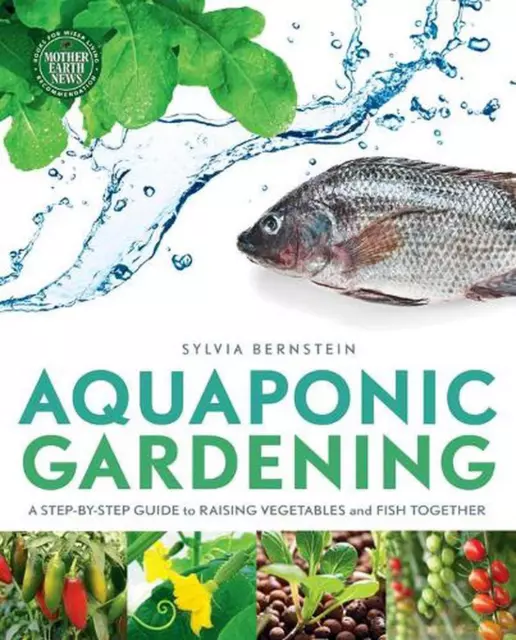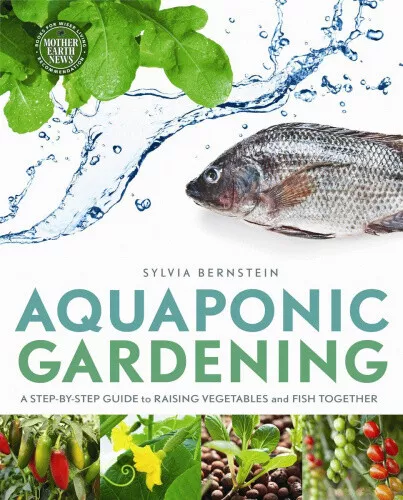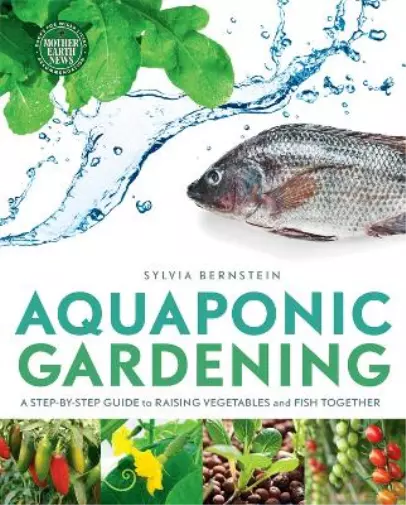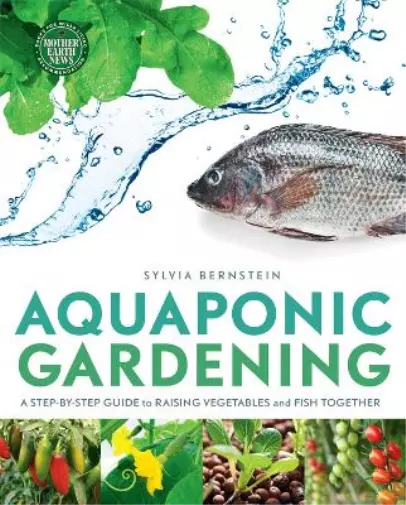Aquaponic Gardening: A Step-by-Step Guide to Raising Vegetables and Fish Togethe
Aquaponic Gardening
by
Sylvia Bernstein
Dive into home aquaponics with this definitive do-it-yourself guide
FORMAT Paperback LANGUAGE English CONDITION Brand NewPublisher Description
Aquaponics is a revolutionary system for growing plants by fertilizing them with the waste water from fish in a sustainable closed system. A combination of aquaculture and hydroponics, aquaponic gardening is an amazingly productive way to grow organic vegetables, greens, herbs, and fruits, while providing the added benefits of fresh fish as a safe, healthy source of protein. On a larger scale, it is a key solution to mitigating food insecurity, climate change, groundwater pollution, and the impacts of overfishing on our oceans.Aquaponic Gardening is the definitive do-it-yourself home manual, focused on giving you all the tools you need to create your own aquaponic system and enjoy healthy, safe, fresh, and delicious food all year round. Starting with an overview of the theory, benefits, and potential of aquaponics, the book goes on to explain:
- System location considerations and hardware components
- The living elements—fish, plants, bacteria, and worms
- Putting it all together—starting and maintaining a healthy system
Author Biography
Sylvia Bernstein: is the president and founder of The Aquaponic Source and the co-Founder and former Vice Chairman of the Aquaponics Association. She also manages AquaponicsCommunity.com, the largest US-based online forum site dedicated to aquaponic gardening. An experienced speaker and internationally recognized expert on aquaponic gardening, Sylvia writes and blogs on the subject for the Aquaponic Gardening Blog, Maxiumum Yield and more. Her inspiration is a large, thriving aquaponic setup in her backyard greenhouse in Boulder, CO powered by tilapia, catfish, bluegill and other creatures-that-swim.
Table of Contents
Introduction; The Soviet Example; Superpower Similarities; The Collapse Gap; Collapse Mitigation; Adaptation; Career Opportunities; Conclusion; Index.
Review
This isn't just another book for dummies; this is a comprehensive handbook on how to grow real food...so meticulously documented, that failure is not an option. -- Jeff Edwards - President, Progressive Gardening Trade Association (PGTA)
I have always wanted to put my money where my mouth is and figure out how to do sustainable aquaculture in the context of my home garden. Finally I've got the book to help me do it. — Paul Greenberg - Best Selling Author, Four Fish: The Future of the Last Wild Food
This is a delightful book to read! ... I've been involved with hydroponics and aquaculture for 30 years and still learned from reading this very thorough how-to book. — Henry A. Robitaille, PhD - Former General Manager, The Land Exhibit, Epcot Center
Promotional
Dive into home aquaponics with this definitive do-it-yourself guide
Long Description
Aquaponics is a revolutionary system for growing plants by fertilizing them with the waste water from fish in a sustainable closed system. A combination of aquaculture and hydroponics, aquaponic gardening is an amazingly productive way to grow organic vegetables, greens, herbs, and fruits, while providing the added benefits of fresh fish as a safe, healthy source of protein. On a larger scale, it is a key solution to mitigating food insecurity, climate change, groundwater pollution, and the impacts of overfishing on our oceans. Aquaponic Gardening is the definitive do-it-yourself home manual, focused on giving you all the tools you need to create your own aquaponic system and enjoy healthy, safe, fresh, and delicious food all year round. Starting with an overview of the theory, benefits, and potential of aquaponics, the book goes on to explain: System location considerations and hardware components The living elements--fish, plants, bacteria, and worms Putting it all together--starting and maintaining a healthy system Aquaponics systems are completely organic. They are four to six times more productive and use ninety percent less water than conventional gardens. Other advantages include no weeds, fewer pests, and no watering, fertilizing, bending, digging, or heavy lifting--in fact, there really is no downside! Anyone interested in taking the next step towards self-sufficiency will be fascinated by this practical, accessible, and well-illustrated guide. Sylvia Bernstein is the president and founder of The Aquaponic Source. An internationally recognized expert on aquaponic gardening, Sylvia speaks, writes, and blogs extensively about this revolutionary technique.
Review Quote
This isn't just another book for dummies; this is a comprehensive handbook on how to grow real food...so meticulously documented, that failure is not an option.
Promotional "Headline"
Dive into home aquaponics with this definitive do-it-yourself guide
Description for Reader
This resource is ideal for anyone working with young people in grades 9-12, whether in schools or in non-formal educational settings. Richly illustrated, it offers 50 teaching strategies that promote learning about natural systems and foster critical thinking about environmental issues, both local and global. It contains new approaches to learning, strategies for living sustainably, and numerous activities that promote interdisciplinary learning. In addition, the book provides suggestions for how best to green individual subject areas, develop integrated learning programs or replicate exemplary programs created by innovative schools and communities. Containing contributions from over 60 educators from across North America, the book's strength lies in its diverse content. Readers learn how best to apply systems thinking, teach about controversial issues and use a step-by-step approach to creative problem-solving in environmental projects. Also provided are instructions for measuring the ecological footprint of a high school, creating an indoor 'living system' that cleans water, monitoring air quality with lichens and using green technologies to help green school campuses. Many articles and activities engage teenagers in outdoor learning and community restoration projects. Suggestions are included for connecting students with special needs to the environment around them. Readers will find accessible background information and suggestions for many practical projects and activities. It is sure to appeal to a wide range of teachers, educators and parents seeking innovative ideas for incorporating green themes into their programs.
Competing Titles
Aquaponics and Food Production ,Rebecca,Nelson,9780977969616,Nelson and Pade Inc,01/01/2008,29.00,
Excerpt from Book
Section 1 An introduction to aquaponics "Here''s to the crazy ones. The misfits. The rebels. The troublemakers. The round pegs in the square holes. The ones who see things differently. They''re not fond of rules. And they have no respect for the status quo. You can quote them, disagree with them, glorify or vilify them. About the only thing you can''t do is ignore them. Because they change things. They push the human race forward. And while some may see them as the crazy ones, we see genius. Because the people who are crazy enough to think they can change the world, are the ones who do." -- Apple Inc. After breakfast Luna, my nine-year-old Tibetan terrier, runs to the door that leads to the back deck whenever I approach it. She knows that soon we need to go feed the fish. After several false alarms, the moment finally arrives when I open the door. She races down the stairs, banks around the corner and skids to a stop in front of the greenhouse. When I finally join her, I open the door and we are both momentarily overwhelmed by the sights, smells and sounds that greet us every morning. The winter aquaponic garden in my greenhouse is alive in a way that the cold, still outside garden can''t possibly aspire to. The warm, moist air smells slightly like freshly turned earth after a spring rain. The sound of flowing water tells of life and energy. The vibrant green plants in various stages and sizes are bursting with promise and productivity. A ladybug flies by. But the best part is the fish. I glance down at Luna, who The author and her dog. Benjamin Rasmussen has pulled herself up on the rim of my 300-gallon stock tank with her front paws to peer at the community within. She never tires of watching them, forever hopeful that someday, if they get just close enough, and she is just fast enough, just maybe... Welcome to aquaponic gardening. With this book I hope to take you on a journey through an entirely different way of gardening. You will learn how to grow plants in rocks using only fish waste as the fertilizer source and bacteria and worms as the bridge between barren toxicity and harmonious fertility. It sounds simple, and in many ways it is, but it can also have a profound effect on your ability to feed yourself and those around you. With this technique you will learn how to grow edible fish to supplement your family''s diet with safe protein you raised yourself. You will learn to grow fruits, vegetables and greens using less than a tenth of the water and without the weeds of a traditional soil garden. And you will be able to grow food anywhere, without the restrictions of soil and sunlight. Aquaponic gardening is a fascinating and enjoyable hobby, but fair warning -- it can be very addictive. Yes, it is a healthy addiction, like yoga or salads, but an addiction nonetheless. For some, this means expanding from time to time to keep "the itch scratched." I''ve seen systems start with a 30-gallon aquarium and one small bed, then become 300 gallons and four beds. Pretty soon the addicts are raising bass and trout in a newly converted backyard pool. My personal experience has been a tale of expansion as well. I started with a 70-gallon pond liner from Home Depot. When that sprung a leak (I didn''t puncture it, I swear), I replaced it with a 120-gallon version -- the fish were getting bigger and needed more room, right? Now I''m up to 120 tilapia and assorted goldfish in five tanks -- four 60-gallon and one 300-gallon. Sad but true. Save yourself while you still can. Chapter 1: What is Aquaponics So what is this crazy, addictive gardening technique? Here is one attempt at a definition: Aquaponics is the cultivation of fish and plants together in a constructed, recirculating ecosystem utilizing natural bacterial cycles to convert fish waste to plant nutrients. This is an environmentally friendly, natural food-growing method that harnesses the best attributes of aquaculture and hydroponics without the need to discard any water or filtrate or add chemical fertilizers. -- Aquaponic Gardening Community, November 2010 The above was the result of a month-long online effort to define this thing called aquaponics. It is an excellent starting point for describing what it is that separates aquaponics from any other growing system available today. Let''s look under the hood at the individual components of this definition: "cultivation" -- This is a system of agriculture for growing the plants and fish we want to consume, rather than a description of a wild, uncultivated environment. "fish and plants together" -- These four words describe the heart of aquaponics. Without fish and plants being grown together, you don''t have aquaponics. "ecosystem" -- The dictionary defines an ecosystem as "a system formed by the interaction of a community of organisms with their environment." Aquaponics is an ecosystem of plants, fish, bacteria and worms. "constructed ecosystem" -- This eliminates plants being grown on the shores of a lake or pond from the definition of aquaponics. While we are centering on a notion of an ecosystem, it must be an ecosystem that is constructed for the purpose of growing fish and plants together. "recirculating ecosystem" -- This constructed ecosystem must also retain its water by recirculating it rather than allowing it to drain off into the water table. This is why aquaponics uses so little water compared to the systems that spawned it. "utilizing natural bacterial cycles to convert fish wastes to plant nutrients" -- This speaks to the key mechanism that enables aquaponics to work. Without the nitrifying bacteria that convert the fish waste into plant food, the fish would soon die in their own waste, and the plants would starve for lack of nutrition. In other words, aquaponics is a system where plants and fish are grown together symbiotically. The waste product from the fish provides the food for the plants, and the plants in turn filter the water that goes back to the fish. This is an environmentally friendly, natural food-growing method that harnesses the best attributes of aquaculture and hydroponics without the need to discard any water or filtrate or add chemical fertilizer. The second part of the definition focuses on the key benefits of aquaponics and introduces the notion that it is really the combination of two other sophisticated cultivation techniques: hydroponics and aquaculture. Both of these techniques require more intervention than an aquaponics system. Aquaculture has to ensure that the waste from the fish is removed before it builds to toxic levels, or the fish will die. Hydroponics requires a constant replenishment and manual balancing of the chemical nutrients, or the plants die. By combining the two systems, aquaponics transfers much of the responsibility for reaching equilibrium between the filtration of the fish waste and the nutrient needs of the plants to Mother Nature. The second part of the definition also asserts that in combining these two techniques, the major problems of each are solved while the major benefits are retained. That is an incredible assertion. Before we go there and decide whether or not it is valid, we should take a moment to talk about hydroponics and aquaponics. Hydroponics Hydroponics is a method for cultivating plants without soil, using only water and chemical nutrients. The "ponics" in "aquaponics" comes from hydroponics. The term "hydroponics" literally means "water working". Much of the greenhouse tomato, basil and lettuce production in North America today is done using hydroponic growing techniques, but you might have also heard of it because it is the favored growing method of marijuana producers. Aquaponics is a hydroponic growing method in that it requires no soil. In both methods, the plants'' roots are constantly bathed in highly oxygenated, nutrient-rich water, and both see growth rates far above those found in soil-grown plants. Aquaponics also borrows from many of the classic hydroponic system types. The flood and drain (also known as ebb and flow) style of growing on which this book focuses comes from the hydroponic world, as do NFT (nutrient film technique) and DWC (deep-water culture or raft) styles. This is where the similarities end, however. Aquaponics is an improvement over hydroponics for the following reasons: Expensive chemical nutrients are replaced by less expensive fish feed. Hydroponic nutrient solutions are expensive, and are gradually becoming more expensive as some ingredients are becoming over-mined and increasingly difficult to acquire. A gallon of hydroponic nutrient solution costs $30-60, and a few tomato plants will easily go through that during their productive lifetime. Meanwhile, a 50-pound (23-kg) bag of tilapia feed costs about the same amount, and at a 1.3 feed conversion ratio will give you 38 pounds (17 kg) of mature tilapia and simultaneously support about eight tomato plants. You never dump out your nutrient solution. Water in hydroponic systems needs to be discharged periodically, as the salts and chemicals build up to levels that become toxic to the plants. This is both inconvenient and problematic, as the disposal location of this waste water needs to be carefully considered. In an aquaponic system, rather than having these problems with chemical imbalance, you achieve a natural nitrogen balance that is the hallmark of an established ecosystem. The water in your system is a critical component that you nurture as part of that balance. In aquaponics, you never replace your water; you only top it up as it evaporates and transpires (evaporates from the leaves of the plants). This saves both water and time. Maintaining an aquaponics system is significantly easier.
Description for Sales People
Author Sylvia Bernstein is the president and founder of The Aquaponic Source, one of only a handful of US based businesses focused entirely on the home aquaponic gardener. She also runs AquaponicsCommunity.com, largest US based online community dedicated to the topic and writes the blog, Aquaponic Gardening which has an average of 2000 readers/week. Intended audiences are current aquaponic gardeners, permaculturists, homesteaders, survivalists, hydroponic gardeners, educators, and backyard gardeners. The author considers aquaponics better than organics,a solution to global warming, world hunger, groundwater pollution, overfishing of oceans Fish make aquaponic gardening unique. They are a healthy form of protein, complete the eco-cycle, are an inexpensive source of fertilizer and add life, fun and enjoyment to gardening The author's goal is for the reader to be able to set up, start and successfully run and maintain their own home aquaponics system Author is widely published in the area of aquaponics including a piece in the February 2010 issue of The New York Times She was featured in a piece by EcoFilms Australia, "Sylvia Bernstein: America's Aquaponics Dynamo" Includes over 70 graphics Mother Earth News book for Wiser Living choice
Details
ISBN086571701X
Author
Sylvia Bernstein
Short Title
AQUAPONIC GARDENING
Publisher
New Society Publishers
Language
English
ISBN-10
086571701X
ISBN-13
9780865717015
Media
Book
Format
Paperback
Imprint
New Society Publishers
Place of Publication
Gabriola Island
Country of Publication
United States
DEWEY
635.048
Pages
288
Year
2011
Illustrations
70 b/w ilus
Publication Date
2011-10-01
NZ Release Date
2011-10-01
US Release Date
2011-10-01
UK Release Date
2011-10-01
Subtitle
A Step-by-Step Guide to Raising Vegetables and Fish Together
Alternative
9781550924893
Edited by
Sylvia Bernstein
Audience
General
AU Release Date
2011-10-10
We've got this
At The Nile, if you're looking for it, we've got it. With fast shipping, low prices, friendly service and well over a million items - you're bound to find what you want, at a price you'll love!
TheNile_Item_ID:137987705;
- Condition: Brand new
- Format: Paperback
- Language: English
- ISBN-13: 9780865717015
- Author: Sylvia Bernstein
- Book Title: Aquaponic Gardening
PicClick Insights - Aquaponic Gardening: A Step-by-Step Guide to Raising Vegetables and Fish Togethe PicClick Exclusive
- Popularity - 0 watchers, 0.0 new watchers per day, 79 days for sale on eBay. 0 sold, 3 available.
- Best Price -
- Seller - 1,210,146+ items sold. 1.8% negative feedback. Great seller with very good positive feedback and over 50 ratings.
People Also Loved PicClick Exclusive

Aquaponic Gardening: A Step-by-Step Guide to Raising Vegetables and Fish Togethe
$39.78 Buy It Now 1d 13h
Aquaponic Gardening: A Step-By-Step Guide to Raising Vegetables and Fish
$66.94 Buy It Now 24d 9h
Sylvia Bernstein Aquaponic Gardening (Paperback)
$67.77 Buy It Now 1d 10h
Aquaponic Gardening: A Step-By-Step Guide to Raising Vegetables and Fish
$62.22 Buy It Now 22d 5h
Sylvia Bernstein Aquaponic Gardening (Paperback) (US IMPORT)
$61.77 Buy It Now 28d 4h
Aquaponic Gardening: A Step-by-Step Guide to Raising Vegetables and Fish
$40.69$39.74 Buy It Now
Aquaponic Gardening: A Step-By-Step Guide to Raising Vegetables and Fish Togethe
$51.38 Buy It Now
